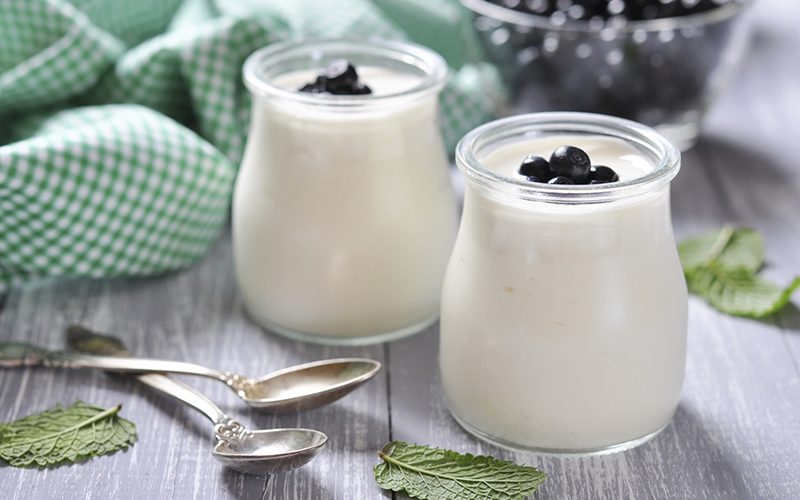
by guest blogger Stephanie Eckelkamp, senior associate editor at Prevention magazine
I’m in a minor predicament: Regular milk-based yogurt makes me feel like garbage, but most nondairy yogurts taste like junk and contain sketchy additives (e.g. controversial carrageenan) to give them that traditional yogurt texture. Blech.
So, what’s a yogurt-lovin’ clean-eating foodie to do? Roll up your sleeves, grab some mason jars, and get ready to DIY.
After plenty of Googling and raiding my kitchen cabinets, I realized I had everything I needed to whip up a batch of wholesome coconut milk yogurt. The coolest part: Turns out you can actually use probiotic capsules in place of a proper yogurt starter, and you certainly don’t need a yogurt maker. Who knew?
So, after a little trial and error, here’s my simple (although a tad bit time-consuming) process for making nondairy (and vegan-friendly) yogurt without the funky additives.
Here’s how to whip up a batch of nondairy coconut milk yogurt that serves 4…
Nondairy Coconut Milk Yogurt
Ingredients:
- 2 (14 oz) cans full-fat coconut milk (I like Native Harvest and Thai Kitchen)
- 1 Tbsp sugar, maple syrup, or honey
- 2 Tbsp tapioca starch, or 2 tsp gelatin (to thicken)
- 4 probiotic capsules (containing one of the following strains: Lactobacillus acidophilus, Lactobacillus bulgaricus, Streprococcus thermophilus, Bifidobacterium lactis)
Directions:
1. First, sterilize four Mason jars with boiling water; set aside. In a medium saucepan over medium heat, combine coconut milk and sweetener (this aids in the fermentation process), and whisk to eliminate chunks. Bring to boil and immediately remove from heat.
2. Spoon a bit of the warm coconut milk into a small bowl along with your thickener of choice (gelatin or tapioca starch) and whisk until combined. Once dissolved, add thickener mixture to saucepan and stir.
3. When coconut milk mixture reaches 115°F (measure this with an instant-read kitchen thermometer), pour the contents of your probiotic capsules into the saucepan and stir to combine.
4. Immediately pour mixture into Mason jars and screw lids on tightly.
5. Now for the slightly annoying part: culturing, or fermenting, the yogurt for 12 to 24 hours (the longer it cultures, the tangier it will be). For this step, you have four different options, depending on the supplies you have on hand. Choose one of the following:
- Place the jars in a cooler filled with hot water between 105° F and 115° F for 12 to 24 hours. You’ll have to replace the water multiple times to keep the temperature up (measure temp with instant-read thermometer).
- If your oven has a proofing cycle, set it to around 100° F, put your yogurt jars in the oven, and allow the yogurt to culture for 12 to 24 hours.
- If your oven doesn’t have a proofing cycle, but it has a light: wrap jars in a towel, place wrapped jars in the oven with only the light on (do not turn on the oven!), and allow the yogurt to culture for 12 to 24 hours.
- Place yogurt jars on top of a heating pad set to medium, cover jars with a towel to insulate, and allow yogurt to culture for 12 to 24 hours.
6. Next, chill the yogurt at least 6 hours to stop the fermentation process and thicken the yogurt.
7. Serve! I topped mine with some homemade granola.
 Stephanie Eckelkamp is a senior associate editor covering food and nutrition at Prevention magazine and is also a certified holistic-health coach. She’s obsessed with her pup, Milo, and loves to get a little crazy in the kitchen. For more from Stephanie, visit StephEckelkamp.com.
Stephanie Eckelkamp is a senior associate editor covering food and nutrition at Prevention magazine and is also a certified holistic-health coach. She’s obsessed with her pup, Milo, and loves to get a little crazy in the kitchen. For more from Stephanie, visit StephEckelkamp.com.
Adapted from a story previously published on EatClean.com




I can’t get my tapioca powder to dissolve completely. Is there a truck; should I sift it into the warm milk mixture instead of spoon it in?